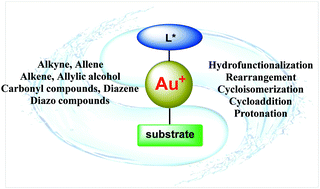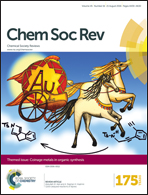Recent advances in enantioselective gold catalysis
Abstract
Interest in homogeneous gold catalysis has undergone a marked increase. As strong yet air- and moisture-tolerant π-acids, cationic gold(I) complexes have been shown to catalyze diverse transformations of alkenes, alkynes and allenes, opening new opportunities for chemical synthesis. The development of efficient asymmetric variants is required in order to take full advantage of the preparative potential of these transformations. During the last few years, the chemical community has achieved tremendous success in the area. This review highlights the updated progress (2011–2015) in enantioselective gold catalysis. The discussion is classified according to the π-bonds activated by gold(I), in an order of alkynes, allenes and alkenes. Other gold activation modes, such as σ-Lewis acid catalyzed reactions and transformations of diazo compounds are also discussed.

- This article is part of the themed collection: Coinage Metals

 Please wait while we load your content...
Please wait while we load your content...